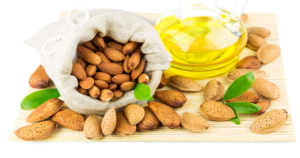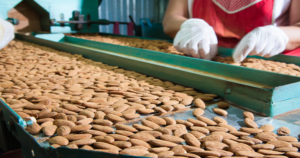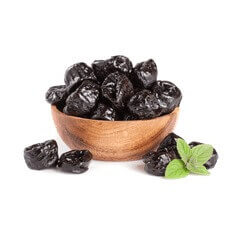Almond Production and Farming Practices
Almonds are one of the world’s most frequently farmed and eaten tree nuts. Many nations cultivate them, including the United States, Spain, Italy, Australia, etc. Almonds are renowned for their delectable flavor, flexibility, and several health advantages. In this blog, we will look at the almond production process and the many farming strategies that go into cultivating almonds.
Orchards of Almonds
Almond trees are usually planted in orchards, which are vast plantations with hundreds or thousands of trees. Almond trees require well-drained soil, plenty of sunshine, and a temperate environment to thrive. Almond trees prefer temperatures between 60 to 70°F, and they require a winter cold period to produce blossoms and fruit in the spring. In other circumstances, the fruits are placed in special machines that remove the hull and even the shell. A good and mature almond tree may yield 50-65 pounds (23-30 kg) of almonds. A mature commercial orchard managed by expert almond producers yields around 4500 lbs. Almonds, unlike other crops, must be maintained year-round, and require a regular water supply. Typical crop fields may be left fallow for a year and recover, but almond orchards cannot. Without water for a few months, the trees perish.
Sweet almonds and bitter almonds
There are two types: sweet almond (P. dulcis, variety dulcis) and bitter almond (P. dulcis, variety dulcis) (P. dulcis, variety amara). Sweet almonds are the most common edible kind, either as nuts or as a source of almond oil or almond powder. Bitter almond oil is used to make flavoring extracts for foods and liqueurs, but prussic acid must be removed first. Bitter almonds and sweet almonds are chemically identical. Both include 35 to 55 percent fixed oil (nonvolatile oil) and contain the enzyme emulsin, which produces glucose in the presence of water. Bitter almonds include amygdalin, which is absent in sweet almonds, and bitter almond oil contains benzaldehyde and prussic (hydrocyanic) acid.

Almond Production and Harvesting
After three to five years of development, almond trees begin bearing fruit, and they can continue to produce almonds for up to 20 years. The blooming almonds bloom in the spring, which is subsequently fertilized by bees and begin the growth process. The pollinated blooms produce little green fruits that ripen into almonds throughout the course of the summer. In the fall, almonds are harvested by shaking the trees to remove the fruit, which is then gathered from the ground. Manually, by striking the nuts from the tree branches with a long pole, or automatically, by shaking them from the tree, almonds are harvested. Almonds are often left on the ground for 7 to 10 days to dry. The almonds that have fallen are then raked into rows.

Farming Practices
Irrigation
Almonds require a steady supply of water to develop properly. To guarantee that the trees receive the proper quantity of water, irrigation technologies such as drip irrigation are commonly used in almond cultivation. While almond trees consume roughly the same amount of water as other fruit and nut trees, plants require more energy and hence more water to produce protein than carbohydrates. So, while nuts require more water than fruits and vegetables, they are high in essential nutrients, healthy fats, and protein. Zones 7 through 9 are ideal for growing almond trees. In the United States, this covers the Southeastern states, Texas, the Southwest, and the coasts of Washington, Oregon, and California to the west, as well as all the way up the coast to Massachusetts to the east.

Pest Management
Almond trees are vulnerable to a wide range of pests, including insects and diseases. Common almond tree diseases are Almond Kernel Shriver, Anthracnose, and Alternaria Leaf Spot. Almond producers may employ a mix of chemical and biological remedies, including pesticides, pheromone traps, and beneficial insects, to reduce the effect of these pests. An integrated pest management approach is required for responsible almond farming, which includes safeguarding the crop and trees against pests, weeds, and disease. This includes employing tools and tactics like as beneficial insects, mating disruption, and pest-level monitoring to ensure that pesticides are applied sparingly and only when necessary.
Sustainable Farming
To save natural resources, decrease waste, and safeguard the environment, many almond producers are embracing sustainable agricultural techniques. These methods may include decreasing the use of toxic pesticides, recycling organic waste through composting, and implementing integrated pest control strategies. The almond is the nut of an almond tree, and practically all of the world’s bulk almonds originate from California. Farmers plant orchards all year and harvest them from August to October.

Crux
Finally, almond production includes planting almond trees in orchards, collecting the crop in the fall, and adopting numerous farming procedures to maintain the quality and safety of the almonds. Almond cultivation is a complicated process that necessitates careful planning, expert labor, and the use of cutting-edge technology. Almond producers are attempting to produce high-quality almonds in an ecologically friendly manner by employing sustainable agricultural strategies.








Almonds - Adnoor
February 16, 2023[…] Almonds are packed with important nutrients that are essential for overall health. They are an excellent source of protein, fiber, healthy fats, vitamins, and minerals. A one-ounce serving of almonds (approximately 23 almonds) contains 6 grams of protein, and 3.5 grams of fiber, and is a good source of vitamin E, magnesium, and calcium. […]